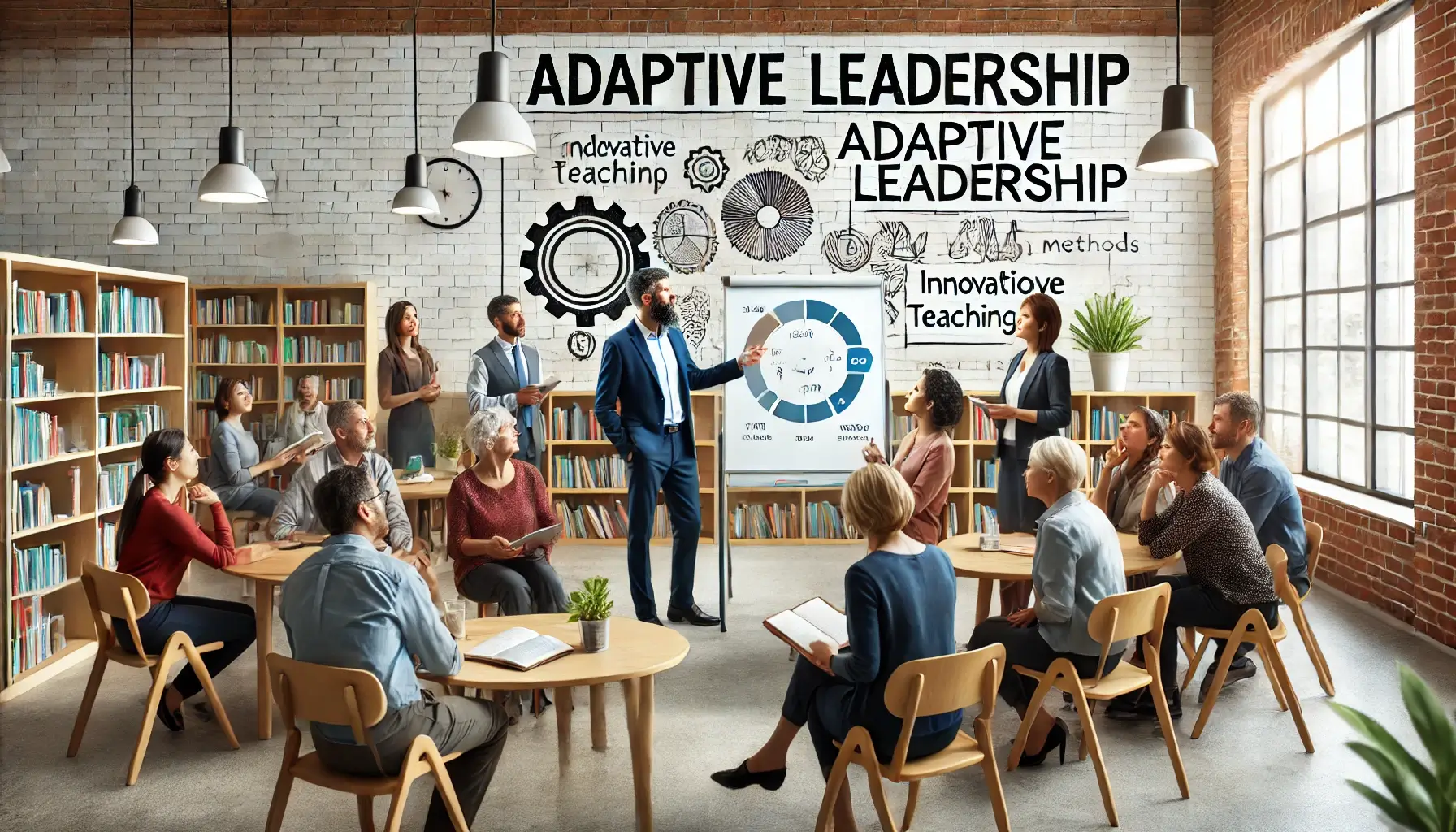Adaptive Leadership Principles and Examples: A Practical Guide

Introduction

In today's rapidly evolving world, leadership strategies must be as dynamic as the environments they aim to navigate. Among the various leadership styles, adaptive leadership has emerged as a vital approach for effectively managing change and fostering innovation. Unlike traditional leadership models that often rely on a fixed set of practices, adaptive leadership encourages flexibility and resilience, enabling leaders to respond to unforeseen challenges with agility and insight.
Adaptive leadership is particularly crucial in our current landscape, where technological advancements and global events continually reshape the way organizations operate. Leaders who can adapt to these changes are better positioned to guide their teams through uncertainty and drive sustainable success. By embracing adaptive leadership principles, organizations can cultivate a culture that values continuous learning and proactive problem-solving, ensuring long-term growth and stability.
What is an Adaptive Leader?
An adaptive leader is able to respond to changing environments and emerging challenges with flexibility and innovation. These leaders create an environment that encourages continuous learning and adapts to new information and situations.
Adaptive leaders possess several key characteristics:
- Emotional Intelligence: The ability to understand and manage one's own emotions, as well as the emotions of others. This trait helps leaders build strong relationships and create a supportive team environment.
- Flexibility: Adaptive leaders need to be flexible in their approach, willing to change strategies as necessary to meet new challenges.
- Resilience: The ability to recover quickly from setbacks and keep moving forward.
- Innovative Thinking: A willingness to experiment with new ideas and learn from both successes and failures.
To find out more about adaptive leadership, explore Atlassian.com.
Understanding the Leadership Style
Adaptive leadership focuses on addressing complex challenges that require new learning and innovation, rather than relying on existing technical solutions. This type of leadership involves engaging team members in the process of adaptive work, encouraging them to experiment and find solutions together.
The adaptive leadership model revolves around four principles:
- Get on the Balcony: Leaders need to step back and gain a broader perspective to understand the dynamics at play.
- Identify the Adaptive Challenge: Differentiate between technical problems and adaptive challenges that require new learning and approaches.
- Regulate Distress: Manage the stress and discomfort associated with change by providing stability and direction.
- Give the Work Back to the People: Empower team members to take ownership of the change process and contribute their ideas.
Importance of Emotional Intelligence in Adaptive Leadership
Emotional intelligence is a critical component of adaptive leadership. It enables leaders to understand and manage their own emotions, as well as those of their team members. Emotional intelligence helps leaders build trust, resolve conflicts, and create a positive work environment.
Leaders should be willing to develop their emotional intelligence to enhance their effectiveness. This involves being aware of one's own emotional responses, understanding the emotional needs of others, and using this awareness to guide decision-making and interactions.
Adaptive leadership focuses on the human aspects of leadership, recognizing that successful adaptation requires addressing the emotional and relational dynamics within a team.
Strategies to Implement Adaptive Leadership
- Develop a Clear Vision: Establish a clear vision and communicate it effectively to ensure everyone understands the goals and direction.
- Foster a Culture of Learning: Encourage continuous learning and development by providing training programs, workshops, and access to resources. Promote an environment where experimentation and learning from failures are valued.
- Encourage Collaboration: Create opportunities for cross-functional collaboration and open communication. Use tools like Slack, Microsoft Teams, and project management platforms to facilitate teamwork and idea-sharing.
- Empower Employees: Delegate responsibilities and trust your team members to handle challenges. Provide the necessary resources and support to enable them to experiment with new approaches and find innovative solutions.
- Monitor and Adjust: Use metrics and feedback to assess effectiveness and make necessary adjustments. Be open to changing strategies based on what is learned during the process. For more information on setting and achieving professional development goals, check out Goalsetting.online.
- Build Adaptive Capacity: Develop the organization's capacity to adapt by fostering resilience and flexibility. Train leaders and employees to think critically, manage change, and respond effectively to unexpected challenges. For more insights on necessary resources to accomplish goals, visit Goalsetting.online.
Addressing Technical and Adaptive Challenges

Difference Between Technical and Adaptive Problems
Technical problems are straightforward issues with clear solutions that can be addressed using existing knowledge and procedures. Examples of technical problems include fixing a broken machine or updating software. These problems typically require technical expertise and can be solved by following established protocols.
Adaptive problems, on the other hand, are complex and require new learning and innovative approaches. These challenges involve changes in attitudes, values, and behaviors and cannot be solved with existing solutions alone. Examples of adaptive problems include transforming organizational culture or responding to significant market shifts.
How to Solve Adaptive Problems
Solving adaptive problems involves several key steps:
- Diagnose the Challenge: Identify the nature of the problem and distinguish between technical and adaptive challenges. Understanding the root causes is crucial for developing effective solutions.
- Engage Stakeholders: Involve all relevant stakeholders in the process. This includes team members, leaders, and other affected individuals. Open communication and active listening are essential for gathering diverse perspectives and building a shared understanding.
- Encourage Experimentation: Create an environment that encourages innovation and allows for trial and error. Leaders should support their teams in trying out new ideas and learning from both successes and failures.
- Build Adaptive Capacity: Develop the organization's capacity to adapt by fostering a culture of continuous learning and flexibility. This involves providing training, resources, and opportunities for professional development.
- Implement and Evaluate: Implement solutions on a small scale to test their effectiveness. Monitor progress, gather feedback, and make necessary adjustments. Continuous evaluation helps refine strategies and ensure their success.
How to Implement Adaptive Leadership?

Steps to Implementing Adaptive Leadership
Implementing adaptive leadership requires a structured approach to foster a culture of flexibility and continuous improvement. Here are the steps to effectively adopt this leadership style:
- Assess Current Leadership Practices: Identify areas that need improvement and assess how well they align with the principles of adaptive leadership.
- Define Adaptive Leadership Goals: Set clear goals that align with the organization's vision and strategic objectives.
- Train Leaders and Employees: Provide training and development programs focused on the principles of adaptive leadership: emotional intelligence, flexibility, and collaborative problem-solving.
- Foster an Adaptive Culture: Encourage open communication, collaboration, and innovation, and recognize behaviors that align with adaptive leadership principles.
- Encourage Experimentation: Support innovative ideas and allow team members to take calculated risks.
- Implement Adaptive Strategies: Start with pilot projects to test new strategies and gather feedback. Use this feedback to refine your approach before scaling it across the organization.
For more information on rinciples of adaptive leadership style, explre Forbes.com.
Dealing with an Adaptive Challenge in Organizations
Adaptive challenges require leaders to engage their teams and foster a collaborative approach. Here are strategies to handle these challenges effectively:
- Identify the Challenge: Clearly identify the adaptive challenge. Understanding the root causes is crucial for developing effective solutions.
- Engage Stakeholders: Involve all relevant stakeholders in the process. This includes team members, leaders, and any other individuals or groups affected by the challenge.
- Provide Support and Resources: Ensure that teams have the necessary support and resources to address the adaptive challenge. This includes providing training, tools, and access to information.
- Monitor Progress and Adjust: Regularly monitor the progress of efforts to address the adaptive challenge. Use metrics and feedback to assess effectiveness and make necessary adjustments.
For additional insights on setting and achieving team goals, visit Goalsetting.online.
Tools and Strategies for Adaptive Leaders
Adaptive leaders need effective tools and strategies to manage change successfully. Here are some essential tools and strategies:
- Communication Tools: Utilize tools like Slack, Microsoft Teams, and Zoom to facilitate open and transparent communication within the organization.
- Data Analytics: Use data analytics tools such as Tableau, Power BI, and Google Analytics to gather insights and make informed decisions.
- Feedback Systems: Implement feedback systems to gather input from employees and stakeholders. Regular feedback helps in identifying issues early and making necessary adjustments.
- Training and Development Platforms: Invest in platforms like LinkedIn Learning, Coursera, and Udemy to provide continuous learning opportunities for employees.
- Collaborative Tools: Promote collaboration using tools like Trello, Asana, and Monday.com. These project management tools help teams plan, organize, and track their work.
For more insights on the tools and strategies for adaptive leaders, check out LinkedIn.com.
Advantages and Disadvantages of Adaptive Leadership
Benefits of Adaptive Leadership Principles
Adaptive leadership offers several significant advantages that can drive organizational success:
- Flexibility: Adaptive leadership promotes flexibility in responding to changing environments. This allows organizations to pivot quickly when faced with new challenges or opportunities.
- Innovation: By encouraging experimentation and learning from failure, adaptive leadership fosters a culture of innovation. This leads to the development of new ideas and solutions that can keep the organization competitive.
- Employee Engagement: Adaptive leaders empower employees, involving them in decision-making processes. This increases engagement, motivation, and job satisfaction.
- Resilience: Organizations led by adaptive leaders are better equipped to handle uncertainty and stress. They build resilience, which helps them survive and thrive in the face of adversity.
- Continuous Improvement: Adaptive leadership emphasizes ongoing learning and improvement, ensuring that the organization constantly evolves and improves its processes and outcomes.
Common Adaptive Leadership Challenges and Pitfalls
Despite its many benefits, adaptive leadership also has some potential drawbacks:
- Time-Consuming: Implementing adaptive leadership can be time-consuming. It requires continuous engagement, feedback, and iterative processes, which can slow down decision-making.
- Uncertainty: Adaptive leadership involves a degree of uncertainty and risk-taking. Not all experiments or new approaches will succeed, which can lead to setbacks and frustration.
- Resource-Intensive: Fostering a culture of adaptability requires significant resources, including training, development programs, and tools for collaboration and feedback.
- Resistance to Change: Employees accustomed to traditional leadership styles may resist the changes required by adaptive leadership. Overcoming this resistance can be challenging and requires strong change management skills.
- Complexity: Adaptive leadership can be complex to implement, requiring a deep understanding of the organization's dynamics and the ability to manage diverse perspectives and conflicting interests.
Weighing the Pros and Cons of Adaptive Leadership
Adaptive leadership's benefits, such as flexibility, innovation, employee engagement, resilience, and continuous improvement, make it an attractive approach for modern organizations. However, leaders must also be mindful of the potential drawbacks, including the time-consuming nature, uncertainty, resource intensity, resistance to change, and complexity.
For more information on the pros and cons of adaptive leadership, visit Indeed.com.
Real World Examples of Adaptive Leadership
Success Stories Featuring Adaptive Leaders
Adaptive leadership is a practical leadership style that emphasizes flexibility and the ability to respond to complex challenges. Here are some success stories that highlight how adaptive leaders have effectively navigated organizational change and driven success.
- IBM's Transformation Under Lou Gerstner: In the early 1990s, IBM faced significant challenges as the demand for mainframe computers declined. Lou Gerstner, the CEO, took an adaptive approach to transform IBM from a hardware-centric company to a services and software provider. Gerstner engaged stakeholders, encouraged innovation, and shifted the company culture towards customer-oriented solutions.
- Howard Schultz and Starbucks' Expansion: Howard Schultz, the former CEO of Starbucks, exemplifies adaptive leadership. Schultz transformed Starbucks from a small coffee bean retailer to a global coffeehouse chain. By focusing on creating a unique customer experience and fostering a strong company culture, Schultz took an adaptive leadership approach that allowed Starbucks to navigate market changes and expand globally.
- Reed Hastings and Netflix's Shift to Streaming: Netflix began as a DVD rental service but faced declining demand with the rise of streaming technology. CEO Reed Hastings applied adaptive leadership by shifting Netflix to a streaming service. This required a complete overhaul of the business model, technology, and customer engagement strategies. Hastings' adaptive approach allowed Netflix to become a dominant player in the entertainment industry.
Lessons Learned from Adaptive Leadership Examples
From these examples, we can draw several lessons about adaptive leadership:
- Flexibility and Innovation: Successful adaptive leaders know the importance of flexibility and innovation. They are willing to experiment and learn from failures to drive adaptive change.
- Engaging Stakeholders: Engaging team members and stakeholders is crucial. Effective communication and collaboration help leaders guide their organizations through complex challenges.
- Continuous Learning: Adaptive leaders must foster a culture of continuous learning and improvement. This ensures the organization can adapt to change and stay competitive.
The Role of Heifetz and Marty Linsky in Adaptive Leadership
Ronald Heifetz and Marty Linsky introduced the concept of adaptive leadership. Their work emphasizes the need for leaders to distinguish between technical problems, which have clear solutions, and adaptive challenges, which require new learning and changes in behavior. Here are their key contributions:
- Distinguishing Challenges: Heifetz and Linsky emphasized the importance of distinguishing between technical challenges and adaptive challenges. This distinction helps leaders apply the appropriate approach to each type of problem.
- Engaging People: They highlighted the need for leaders to engage their teams and stakeholders in the process of change. Adaptive leadership encourages participation and collaboration.
- Building Adaptive Capacity: Heifetz and Linsky's framework focuses on building the adaptive capacity of organizations. This involves fostering a culture of learning, innovation, and resilience.
For more insights on the principles of adaptive leadership, you can visit Goalsetting.online.
Conclusion
Adaptive leadership is a flexible and dynamic style of leadership introduced by Ronald Heifetz, emphasizing the importance of adaptability and continuous improvement. The adaptive leadership framework is built on four main principles of adaptive leadership: getting on the balcony, identifying adaptive challenges, regulating distress, and giving the work back to the people. This leadership framework helps leaders to challenge the status quo and create an adaptive culture within their organizations. Traits of adaptive leaders include emotional intelligence, resilience, and a willingness to experiment. The practice of adaptive leadership revolves around these principles and encourages leaders to adapt to emerging challenges. Examples and principles from adaptive leadership theory demonstrate how adaptive leadership works in real-world scenarios, providing numerous advantages of adaptive leadership.
Adaptive leadership provides the tools needed to address complex problems and foster innovation. Although adaptive leadership is different from traditional approaches, its focus on flexibility and experimentation makes it an effective style of leadership. By embracing the main principles of adaptive leadership, leaders can overcome the unwillingness of leaders to change and build resilient organizations. Adaptive leadership helps organizations face challenges and emerge stronger by creating adaptive strategies that align with the evolving environment. This approach ensures that leaders are well-equipped to handle uncertainty and drive continuous growth and development.
FAQs
What are the principles of adaptive leadership?
Adaptive leadership is based on four main principles:
- Get on the Balcony: Leaders must step back and gain a broader perspective to understand the dynamics and patterns within their organization.
- Identify the Adaptive Challenge: Distinguish between technical problems and adaptive challenges that require new learning and innovation.
- Regulate Distress: Manage the stress and discomfort associated with change by providing stability and direction while pushing the organization to address difficult issues.
- Give the Work Back to the People: Empower team members to take ownership of the change process, fostering engagement and collaboration.
How is adaptive leadership different from other leadership styles?
Adaptive leadership is different from traditional leadership styles in several ways:
- Flexibility: Adaptive leadership is highly flexible, focusing on the ability to respond to changing circumstances and unexpected challenges.
- Collaboration: It emphasizes collaboration and involving team members in decision-making processes, unlike more hierarchical traditional leadership styles.
- Continuous Learning: Adaptive leadership encourages continuous learning and innovation, while traditional leadership often relies on established practices and routines.
What are some examples of adaptive leadership in practice?
- IBM's Transformation: Under Lou Gerstner, IBM shifted from a hardware-centric company to a services and software provider, adapting to changing market demands.
- Starbucks' Expansion: Howard Schultz transformed Starbucks into a global coffeehouse chain by focusing on customer experience and company culture.
- Netflix's Shift to Streaming: Reed Hastings led Netflix's transition from DVD rentals to a streaming service, revolutionizing the entertainment industry.
How can one develop adaptive leadership skills?
To develop adaptive leadership skills, consider the following steps:
- Continuous Learning: Engage in ongoing education and professional development to stay informed about industry trends and new leadership practices.
- Seek Feedback: Regularly seek feedback from team members and stakeholders to understand their perspectives and improve your leadership approach.
- Experiment and Innovate: Encourage experimentation within your team and be willing to take calculated risks. Learn from both successes and failures.
- Build Emotional Intelligence: Develop emotional intelligence to better understand and manage your own emotions and those of others, fostering stronger relationships and team dynamics.
What are the benefits of adaptive leadership?
- Increased Flexibility: Organizations can quickly respond to changes and unexpected challenges.
- Enhanced Innovation: Encouraging experimentation and learning leads to the development of new ideas and solutions.
- Higher Employee Engagement: Empowering team members and involving them in decision-making processes increases engagement and job satisfaction.
- Greater Resilience: Organizations build resilience by fostering a culture that values continuous learning and adaptability.